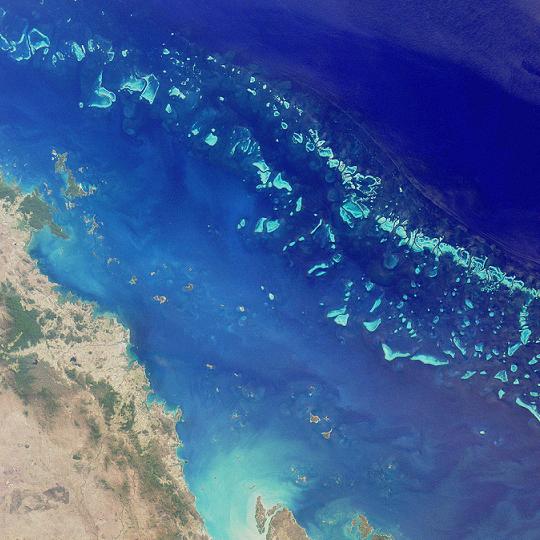 |
usa | world | animals | vocabulary | health | science | math | history |
The Great Barrier Reef
The Great Barrier Reef is the world's largest coral reef. The reef is located in the Coral Sea off the coast of Queensland in north-east Australia. It stretches over 2000 kilometres in length and can be seen from space.
The first European explorer to see the Great Barrier Reef was Captain James Cook during his 1768 voyage. Cook discovered the reef by running aground on it June 11, 1770.
Due to its vast biodiversity, warm clear waters and its accessibility from the floating guest facilities called 'live aboards', the Reef is a very popular destination for scuba divers. Many cities along the Queensland coast offer boat trips to the reef on a daily basis. Several continental islands have been turned into resorts.
The Great Barrier Reef is sometimes referred to as the single largest living animal being in the world. In reality it is many colonies of corals.

The Great Barrier Reef seen from space.(courtesy NASA)
A large part of the reef is protected by the Great Barrier Reef Marine Park.
The Great Barrier Reef is a large system of about 3000 reefs and 900 islands that are mostly offshore. The coastline of north eastern Australia has no major rivers, except during tropical flood events caused by cyclones (hurricanes), and no major towns, the largest being less than 150,000 people. By world standards the Reef is under only light environmental stress compared to all others.
However, some 400 of the 3000 reefs are within a risk zone where water quality has declined owing to sediment and chemical runoff from farming, and to loss of coastal wetlands which are a natural filter. Principal agricultural activity is sugar cane in the wet tropics and cattle grazing in the dry tropics regions. Both are considered significant factors affecting water quality.
The most significant threat to the future of the Great Barrier Reef and of the planet's other tropical reef ecosystems is global warming. Many of the corals of the Great Barrier Reef are currently living at the upper edge of their temperature tolerance, as demonstrated in the coral bleaching events of the summers of 1998 and 2002. Under the stress of waters that remain too warm for too long, corals expel their photosynthesizing zooxanthellae and turn colourless, revealing their white skeletons, and if the water does not cool within about a month the coral dies.
Global warming has triggered the collapse of reef ecosystems throughout the tropics. Increased global temperatures bring more violent tropical storms, but reef systems are naturally resilient and recover from storm battering. With an upward trend in temperature apparently continuing, much more coral bleaching is expected to occur in the coming decades.
Crown-of-Thorns starfish are predators of corals. They have a life cycle with many eggs released annually, that enables this species to boom-and-bust like locusts in a desert. The cycles are thought to be enhanced by declines in water quality such as excess nutrients from farm runoff. About 1/3 of the entire system has been affected since the 1960s.
There are over 1 million visitors to the Great Barrier Reef each year. Although most of these visits are highly regulated, there are some very popular areas near shore, like Green Island that have suffered damage from tourist activity.
On July 1, 2004 the reef became the largest sea reserve in the world when the Australian Environment Ministry increased the protected area from 4.5% to 33.3%. It was inscribed as a World Heritage site in 1981. The government applies both regulations as well as education and incentives (such as eco-tourism certification) in its effort to conserve the Great Barrier Reef.
This article is licensed under the GNU Free Documentation License. It uses material from the Wikipedia article "Great Barrier Reef".